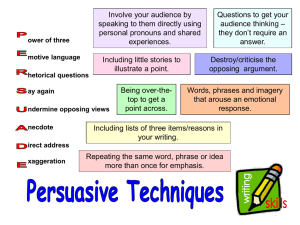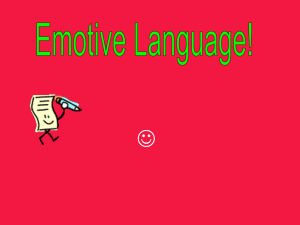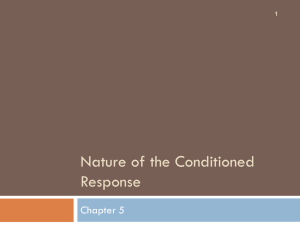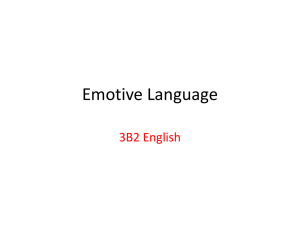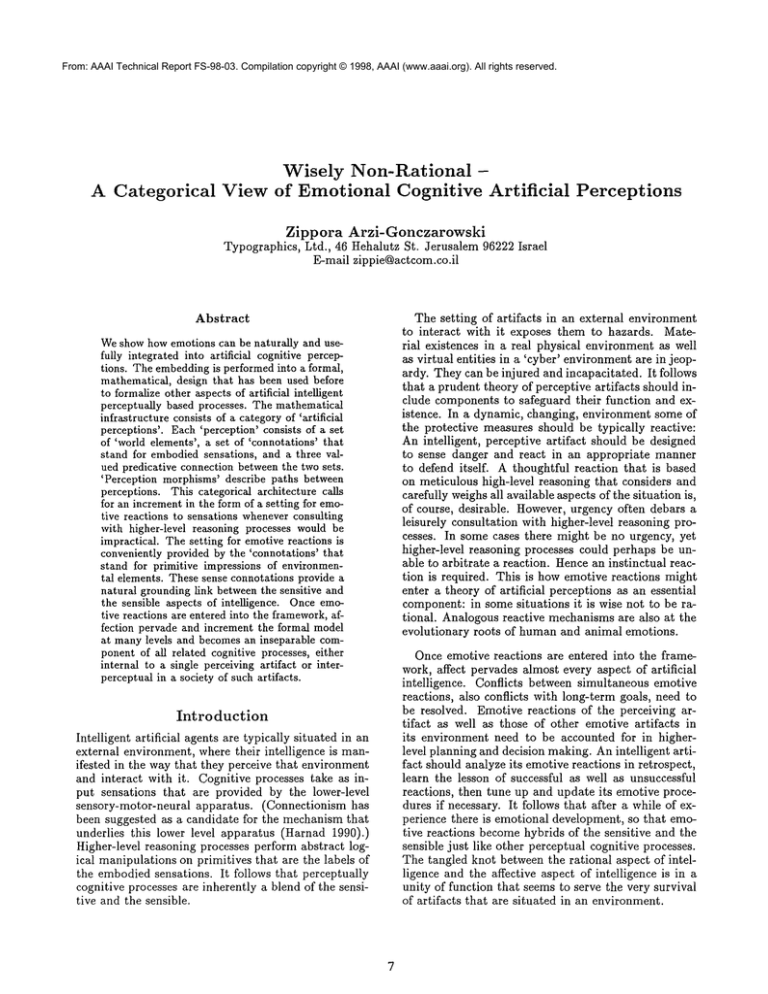
From: AAAI Technical Report FS-98-03. Compilation copyright © 1998, AAAI (www.aaai.org). All rights reserved.
A Categorical
Wisely Non-Rational
View of Emotional Cognitive
Artificial
Perceptions
Zippora
Arzi-Gonczarowski
Typographics, Ltd., 46 Hehalutz St. Jerusalem 96222 Israel
E-mail zippie@actcom.co.il
Abstract
The setting of artifacts in an external environment
to interact with it exposes them to hazards. Material existences in a real physical environment as well
as virtual entities in a ’cyber’ environmentare in jeopardy. They can be injured and incapacitated. It follows
that a prudent theory of perceptive artifacts should include components to safeguard their function and existence. In a dynamic, changing, environment some of
the protective measures should be typically reactive:
An intelligent, perceptive artifact should be designed
to sense danger and react in an appropriate manner
to defend itselfi A thoughtful reaction that is based
on meticulous high-level reasoning that considers and
carefully weighsall available aspects of the situation is,
of course, desirable. However, urgency often debars a
leisurely consultation with higher-level reasoning processes. In some cases there might be no urgency, yet
higher-level reasoning processes could perhaps be unable to arbitrate a reaction. Hencean instinctual reaction is required. This is how emotive reactions might
enter a theory of artificial perceptions as an essential
component: in some situations it is wise not to be rational. Analogous reactive mechanismsare also at the
evolutionary roots of human and animal emotions.
Weshowhowemotions can be naturally and usefully integrated into artificial cognitive perceptions. The embeddingis performedinto a formal,
mathematical, design that has been used before
to formalizeother aspects of artificial intelligent
perceptually based processes. The mathematical
infrastructure consists of a categoryof ’artificial
perceptions’. Each’perception’ consists of a set
of ’world elements’, a set of ’connotations’ that
stand for embodiedsensations, and a three valued predicative connection betweenthe two sets.
’Perception morphisms’describe paths between
perceptions. This categorical architecture calls
for an incrementin the form of a setting for emotive reactions to sensations wheneverconsulting
with higher-level reasoning processes would be
impractical. The setting for emotivereactions is
conveniently provided by the ’connotations’ that
stand for primitive impressions of environmental elements. These sense connotations provide a
natural groundinglink betweenthe sensitive and
the sensible aspects of intelligence. Onceemotive reactions are entered into the framework,affection pervade and increment the formal model
at manylevels and becomesan inseparable component of all related cognitive processes, either
internal to a single perceivingartifact or interperceptual in a society of such artifacts.
Once emotive reactions are entered into the framework, affect pervades almost every aspect of artificial
intelligence. Conflicts between simultaneous emotive
reactions, also conflicts with long-term goals, need to
be resolved. Emotive reactions of the perceiving artifact as well as those of other emotive artifacts in
its environment need to be accounted for in higherlevel planning and decision making. An intelligent artifact should analyze its emotive reactions in retrospect,
learn the lesson of successful as well as unsuccessful
reactions, then tune up and update its emotive procedures if necessary. It follows that after a while of experience there is emotional development, so that emotive reactions becomehybrids of the sensitive and the
sensible just like other perceptual cognitive processes.
The tangled knot between the rational aspect of intelligence and the affective aspect of intelligence is in a
unity of function that seems to serve the very survival
of artifacts that are situated in an environment.
Introduction
Intelligent artificial agents are typically situated in an
external environment, where their intelligence is manifested in the way that they perceive that environment
and interact with it. Cognitive processes take as input sensations that are provided by the lower-level
sensory-motor-neural apparatus. (Connectionism has
been suggested as a candidate for the mechanismthat
underlies this lower level apparatus (Harnad 1990).)
Higher-level reasoning processes perform abstract logical manipulations on primitives that are the labels of
the embodied sensations. It follows that perceptually
cognitive processes are inherently a blend of the sensitive and the sensible.
7
Wepropose a mathematical categorical architecture
of artificial perceptions as a frameworkthat can readily model artificial emotions and their function. These
categorical premises have already been shown to provide infrastructure for quite a few high-level cognitive processes (Arzi-Gonczarowski ~ Lehmann1998b;
1998a; Arzi-Gonczarowski 1998b; 1998a). The mathematical primitives are generalized reactions. Sensations enable unmediated embodied interaction with the
environment, as well as mental perception, reasoning,
and rational judgement. Affect is often linked to perception: (z) The agent’s ownemotive reactions are often conjured by perception of something in its environment, as in being startled by an approaching vehicle.
(zz) The agent often uses its perception to recognize
emotions of other agents. It will be argued that even
in cases where there is no connection between an emotion (or a thought) and the currently perceived environment, there is typically a link that can be traced to
perceptual processes that are at the roots of things.
Contextualization
Ever since the Garden of Eden the humansociety has
been documenting and analyzing its experience with
emotive reactions. It is therefore hard to say anything new about human emotions that has not been
said before. AI related research about emotions, including computational models, typically has the goal
of understanding, illuminating, imitating, and synthesizing human affect processes. Picard (Picard 1997)
discusses requirements for emotionally intelligent computers, applications of affective computing, moral and
social questions raised by the technology, and the design and construction of affective computers. The
approach is wide ranging, yet from a human angle.
(Blumberg 1994; Bates 1994; Maes 1995; Kitano 1995;
Reilly 1996; VelEsquez 1997), amongothers, describe
architectures and computational models for believable
synthetic agents as well as for learning and adaptation. (A review of a few more computational proposed
models appears in (Pfeifer 1988).)
The proposed mathematical categorization of artificial perceptions offers a neutral approach to cognition
and affect. Emotional artificial behavior is not necessarily based on the imitation of human emotions. As
just argued, emotive reactions are needed, hence natural, in perceptually cognitive artifacts that sense an
environment with which they interact. It may well be
that the sensation, the drive and the resulting activity are totally foreign to humanexperience, yet it is
still an emotive reaction. It is proposed to start from
generalized basic reactive mechanisms that typically
vary for particular agents and environments. Building
on these basic emotive reactions, categorical constructions provide a broad spectrum of generalized affective
processes, with complex emotional behavior that runs
parallel to higher level cognitive processes.
This study introduces a novel approach in the in-
troduction of a neutral categorical mathematical architecture, where no such framework already exists.
Most aspects of emotions that it captures are already
in the literature, typically with respect to humanemotions. (As Magnan and Reyes have observed (Magnan & Reyes 1994), categorical constructs generalize,
providing means to avoid over-determinations.) Sloman et at. (Sloman, Beaudoin, & Wright 1994) argue
that there are multiple layers of emotional phenomena.
Damasio (Damasio 1994) also makes a distinction between primary and secondary emotions. The idea that
there are different levels of emotions is also supported
by the categorical architecture that is proposed here.
(Whether it supports parallel layers to those in the
cited literature remains to be looked into.) The idea
that there is a close connection between perception and
emotions is emphasized by Picard (Picard 1997).
The advantages of mathematical formalizations, as
argued in the introduction to (Croon ~ de Vijver
1994), include clarity, precision, versatility, generalizability, testability,
allowance to model complex phenomena that are far too complex to be grasped by a
verbal description, and allowance to use results of a
well developed science. Lawvere states (Lawvere 1994)
that: ’Even within mathematical experience, only [category] theory has approximated a particular model of
the general, sufficient as a foundation for a general
account of all particulars’ The Mathematical categorization provides a setting for the approximation of
affective, cognitive, behavior by describing particular
models, as well as foundations, for an account of such
behavior.
Basic Mathematical
Constructs
Definition
1 A Perception
is a threc-tuple
79 = ($,Z, ~) where $ and Z are finite, disjoint sets,
andQ is a 3-valuedpredicateQ : $ ×:T. --+ { t, f, u}.
The set £ represents the environment which is perceived. Anything which could perhaps be discerned
by perception could be a legitimate element of £, and
hence a world element (w-element for short).
The set Z stands for internal sensations that are conjured by world elements. Its elements have a subjective
existence dependent on the machine. These are the
building blocks of subjectively experienced, referable,
sensations. Anything which may be stored and manipulated by a cognitive artifact (words, symbols, icons,
etc.) could represent a legitimate element of Z, and
hence a connotation. The import of this study is based
on the coupling of reactions with connotations. Connotational reactions are conceived to be independent of
other intellectual and reasoning processes that might
be impelled by higher-level reasoning processes following complex logical reasoning. Any reaction could
count as such, including, but not restricted to, a simple acknowledgement of the emotive connotation that
has been conjured (the human analog is a verbal expression of the emotion). Another typical emotive re-
action could involve a shift in the focus of attention.
Wewill show that this augmentation of the categorical premises provides basis for a broad spectrum of
emotional activity.
The three-valued predicate ~ is the Perception Predicate (p-predicate for short) which relates w-elements
and connotations. Provided that we now couple connotations with reactions, then if ~(w, a) = t, then w
perceived as having connotation a, and this impels an
associated reaction, say a t. Likewise, if ~(w,a) =
then w is perceived as lacking connotation a, and this
impels an associated reaction, say v~f. If ~(w, (~)
then it is undefined whether perception of w should impel any of these reactions. Reactions could be empty,
and in that case one gets back to the original premises
of the cited works. The issue of why the p-predicate has
any one of the three values at a certain point simply
warrants no discussion: sensations are not necessarily
explained, not at the (virtual) level of the proposed categorical architecture. Actual g and Z, with reactions,
and the values of the p-predicate, once given, provide a
definition of a particular perception, which is a mathematical object that virtually stands for an embodied
affective-cognitive perceptual state. This captures the
intuition that perceptions and sensations are innate
to agents: their gestalt perceptions, mental imagery,
neural-sensory-motor apparatus, function, internal organization affective state, etc. Perceptions are highlevel in the sense that they reside higher than pixels
on the screen or waveforms of sound. They are object
centered and therefore happen at and above the level
of recognition of cohesive wholes, where meaning and
conscious cognizance begin to play a role.
The flexible dynamic flow between different highlevel perceptions is formalized by morphisms:
Definition2
Let Pi = ($i,:Z’i,~i)
and 7)2
($1,I2,~02) be two perceptions, h : 7)1 -’-* 7)2 is Perception Morphism(p-morphism for short) if h defines
the following set mappings with a structure preserving condition: h : $1 --~ $2, h : Z1 ~ Z2, and NoBlur is the structure preservation condition: For all
w C $1, and for alla e Z1, whenever ~l(w,~) ~
then ~2(h(w), h(a)) = #l(w,
Composition of p-morphisms and the identity
pmorphismare defined at the level of set mappings, and
a theorem follows that perceptions with p-morphisms
make a mathematical category, designated 7)rc. This
provides a well developed mathematical infrastructure
for a ’theory of artificial perceptions’ (in the samemanner the category of groups is basis for group theory).
Various types of p-morphisms have been shown to
generalize various types of transitions between perceptions (improving, communicative, analogical, and
others). In the case of affective perceptions, consider
a perception 7) = (g,Z, ~) with connotations 2:
{accept, reject}, that are coupled with suitable reactions. A simple example p-morphismh : 7) ~ 7)1 could
be based on the identity mapping of w-elements, and
the following mapping of connotations: h(accept)
reject, h(reject) = accept with rigid structure preservation: ~’(h(w),h(a)) = ~(w,a), namely P’ rejects
exactly whatever 7) accepts, and vice versa. In this
example h is a p-isomorphism. This captures a simplistic transition, and systematizes the intuition that
conversion between two extremes, both affective and
cognitive, is typically easier than a total redefinition of
perception and attitudes. The pre-theoretical intuition
is that transitions between perceptions that are based
on p-morphisms are, in a sense, ’smooth’. The mathematical properties of the p-morphism (isomorphism,
one to one, many to one, onto, impossible etc.) carry
meticulous information about how close these perceptions are, and pinpoint differences between them. We
later provide further examples of correlations between
the relative complexity of mathematical constructs and
the intricacy of affective-cognitive processes.
Higher
Level
Constructs
Given a perception in an environment, simultaneous
excitation of multiple emotive reactions is not unexpected. This could be due to several distinct welements, and/or one w-element that conjures multiple connotations. Simultaneous reactions could possibly conflict. Competition for a focus of attention is
one possible example. There are higher-level reasoning
and decision making methods that could sometimes be
applied to resolve such conflicts. It is often the case,
however, that higher level processes cannot provide a
decisive arbitration. In other cases, as argued before,
limited resources debar a leisurely consultation with
higher-level reasoning processes. It remains to resort
to solutions that are essentially affective because they
are not based on obvious rational analysis.
The idiosyncratic way in which multiple emotive reactions are put together could vary. Emotive reactions
could cancel one another, or tone one other down or
up, or take priority one over the other, or put the
entire system in a deadlock...The manner in which
compound emotive reactions are handled would capture own inclinations and temperament with respect
to a broad spectrum of affections. A few possible examples: Does an ambition to achieve a goal precede
caution? Does competition precede a prior promise?
Does institutional legality precede social obligation?
In the proposed formal model of artificial
perceptions, affective-cognitive control of multiple emotive reactions can be featured in the subcategory of Boolean
perceptions, where sets of connotations are closed under Boolean operations, namely the :r’s are Boolean
algebras. (Arzi-Gonczarowski & Lehmann1998a) provides a deductive apparatus for the computation of the
three-vMued p-predicate for Boolean combinations of
connotations. A Boolean combination of connotations
is then itself a connotation, and hence nowalso coupled
with an emotive reaction that can mediate between the
multiple emotive reactions. A w-element that happens
to be a computer program could be perceived, for instance, as ~(w,-~identified A it_knows_the_password)
t. The complex connotation impels control of the multiple emotive reactions. This should consist of a resolution of the conflict: Should the perceiving artifact
perhaps trust the stranger, or shut downimmediately,
or linger to trace an intruder...
(Arzi-Gonczarowski & Lehmann 1998a) provides
categorical natural transformations that captures methodical classification and logical representation formation: Starting from basic neural-sensory-motor perceptions, organize and shape structured representations of labeled sensations that can be further used
for higher-level processes. Basic neural-sensory-motor
perceptions are mapped into their Boolean closures.
With added emotive reactions that are now impelled
by connotations, the cognitive process is also an affective process. The contents of the complex connotation
comes coupled with a compoundemotive reaction. The
mediated reaction could, for example, be based on: (~)
Predetermined precedence between basic emotive reactions, capturing predetermined ’traits of character’.
(Random precedence, for example, would capture an
unpredictable character.) (u) Fast heuristic decision
making, capturing a form of ’gut feeling’. (Freeze all
reactions to wait and ’think’ is, in this context, an example of a reaction.)
Twocanonical free constructions from the category
of perceptions (or some subcategory) into the Boolean
subcategory formalize reasonable ways to go about
producing the Boolean closure. One is based on a
general free construction. It provides for all possible
Boolean combinations of connotations and associated
reactions in a general, methodical manner. The second construction is more ’perceptually acute’, and it
answers to a criterion of mathematical completeness.
This gives rise to even more cognitive-affective contents, because this construction provides for internalization of perceived lawlike patterns. For example,
if, for all w-elements w, the p-predicate is such that
~(w, half_full) = O(w, half_empty), then this construction merges the connotations half_full and half_empty,
capturing a cognitive internalization of this pattern.
The two connotations may be, indeed, associated with
different, possibly conflicting, emotive reactions. The
process thus gives rise not only to an emerging compound emotive reaction, but also to cognitive awareness of the conflicting emotions.
P-morphisms in the Boolean subcategory are based
on Boolean homomorphisms, capturing a structural
similarity between the perceptions involved.
tions of Q, for instance o(Q, tired) = Fatigue co uld
stand for lack of energy, a state that impels the agent
to reach for a recharging socket - an overt action that
can be perceived.
Perceiving emotions in other agents provides, among
others, the necessary basis for empathy, which is, in
turn, a foundation for forms of moral, ethical, and social behavior. Consider a situation where w is a welement that stimulates an emotive reaction of repulsion in Q (it can be observed that Q = (:P, if, r} avoids
proximity to w, T(w, repulsion) = 0. Consider another emotive perception, 79 = ($, 2:, ~), that perceives
Q and its reaction to w: #(Q, avoids w) = t. An empathic reaction of 79 would be either to also avoid w,
or to behave in a pro-active, pro-social, manner and
’help’ Q by getting w out of its way. Either reaction is
not necessarily desirable. 79 should distinguish its own
emotions from those of others, and preserve its own
interests and goals even within a pro.social, harmonious society. Empathic reactions could be regulated
within the proposed formal framework of perceptions
with compoundemotions as explained above: If79 also
perceives that ~(Q, Itls_me) = ~ then this should invoke a competing emotive reaction to subdue the empathic reaction to 79’s own interests. The extent of
the pro.social (perhaps even altruistic) behavior that
should result depends on the idiosyncratic resolution
of the emotional conflict, as discussed before.
In the general case 79 could perhaps perceive an entire collection of other emotive perceptions such as Q.
If its perception is able to distinguish amongthem and
identify each one separately, then it should also be able
to feature a different degree of interested empathywith
each and every one of them, formalizing a broad spectrum of inter-agent relationships.
Sensible intelligence is typically marked by a discerning perception and understanding of its environment. Another pre-theoretical intuition is that observation and internalization of the peculiarities and the
special patterns of a given environment are also a perceptual task. There are lawlike patterns which can
be observed: one sensation may suggest another, some
sensations come always together while others never do,
and there are other possible connections as well. Given
a perception 79 = {$,I, 0}, $ and 0 introduce a structural element into the internal representation 2- of connotations/sensations.
The proposed theory of artificial
perceptions pro.
vides means for formalizing observation of lawlike
patterns between connotations and between Boolean
combinations of connotations. The example half_full
= half_empty appeared above. A general lawlike
pattern between connotations is defined by (ArziGonczarowski & Lehmann 1998a):
Definition 3 Let 79 = {$,2-, ~} be a perception, and let
a, fl E 7?. a subsumes/~, denoted o~<lfl, if for all w
in $, O(w,~) = t ~ O(w, fl) = t and ~(w, fl)
Perceiving Reactions
In the sections above we focused on emotive reactions
of a single perceptive artifact. An affective artifact
Q could constitute a perceptible w-element in the environment of another affective perception 79. In that
case 7) could perhaps be able to perceive emotive reac-
~(~,~) = f.
10
A perception can observe the patterns of its ownconnotations, enhancing a certain sense of ’self awareness’.
In yet other cases, if a and fl in the definitions describe perceived reactions of other artifacts, then their
patterns of reaction can be observed as well. Categorically, there is no difference betweenthe following two
observations: (z) Let £ be an environment with containers of gaz. The pattern compressed<3heated is an
expected observation. (zz) Let £ be an environment
infants. The pattern hurt<] tears is an expected observation. Wehumans distinguish the first observation
as ’cognitive’ and the second as ’affective’ because we
react with empathy only to the crying infant. An observing artificial perception wouldmakesuch a distinction only if it were equipped with distinct reactions to
heated gaz and to crying infants.
Observedlawlike patterns can be entered into the internal perceptual cognitive image. This is formalized
by the canonical free construction (mentioned above)
that incorporates observed patterns into the Boolean
structure. A cognitive perception that is observing
and perceptually acute can thus be ’emotionally intelligent’ (Goleman1995). It can be both affectively
and cognitively aware of its emotive reactions and the
emotive reactions of others, and eventually use these
observations in higher-level reasoning. Planning or decision making that are based on an internal cognitive structure into which the observed emotions are
internalized would naturally incorporate this knowledge into the reasoning processes. Affective-cognitive
perceptions would, for example, anticipate a reaction
of tears whenevera child is hurt, and take precautions
before, say, administration of an injection. Nurses who
do this routinely becomeless sensitive, and do not react with such painful visceral feeling to the tears, yet
there remains the cognitive apprehension of the pattern
with the resulting considerate precautions, and nobody
would have said that these nurses are not affective.
Perhaps the counterpart to empathic perceptions
would be observing perceptions in a competitive society, that perceive ’weaknesses’ of emotive artifacts and
harness the observations to their own benefit. An observant perception could, for instance, record the pattern surprise<3 distraction_of_focus, then conceive and
devise an environmental cause of surprise that should,
in turn, bring about the anticipated distraction of focus: make the adversary blink first. Affective perception is not necessarily ’nice’.
Emotional
Development
Emotive connotations do not need a symbol or a collocation to impel action (Brooks 1991), however a symbol and a collocation provide means of reference to
the sensation, the drive, and the activity. This enables later retrospective analysis and update of the
conjured emotive reaction. The proposed theory of
artificial perceptions suggests that perceptions should
generate internal representations that are schemedand
organized, individually for every perception and environment, as Boolean lattices generated over the basic sensory-motor-neural apparatus. Emotive reactions
are hence labeled and collocated on the Boolean lattice. This provides a natural setting for ’emotional
development’.
Emotive reactions can be revised by external catalysts and/or learning from experience. Just as one
expects that an intelligent artifact should benefit from
its experience whenit forms an internal cognitive image of its environment (Nilsson 1995), it is also reasonable to expect that an intelligent artifact should
benefit from its experience when it adapts and models its emotional behavior. After having endured an
’emergency’, or maybe even parallel to the stimulation of an emotive reaction, it should be good practice
to also summonhigher level reasoning processes that
consider and carefully weigh all available aspects of the
situation. These could be applied to evaluate the performance of the emotive reaction. This provides an
opportunity to sort out the emotions involved, draw
retrospective conclusions, then either reinforce a successful reaction or update and modify a less successful
one. As a result the emotive reactions are improved by
learning from experience and by reasoning processes,
and the updates are collocated in their natural ’slot’.
Memorycapabilities of artificial
perceptions can
benefit emotional development by keeping track, for
every emotive reaction, of its history of stimulations
and resulting updates. (Of course, memorytasks are
typically performed more rigorously by artificial perceptions then by humans.) l~etrospective evaluation
processes should be able to access the emotional history through the embodied ’slots’ to reason about the
causes of certain reactions.
The internal lattice graph, offering sloping lines with
eventual shortcuts like ’ladders and ropes’, can serve
as basis for mental processes. By sliding along the
gratings of the Boolean trellis, internal ’thought’ processes can activate the emotive reactions. Activation
of emotive reactions by thought processes is, indeed, a
familiar humanexperience. It can be supported by the
proposed categorical architecture.
Emotions and Conceived Perceptions
Creative design processes are examples of internal
’mental’ processes that could conjure emotive reactions. The proposed theory of artificial
perceptions
provides categorical tools for perceptual transitions
from perceptions of actual environments to an internal conception of environments that are based on categorical natural transformations of actual perceptions
(Arzi-Gonczarowski 1998a). An ’internal’ perception
of a conceived environment may conjure emotive reactions as well. In that case there seems to be no
connection between an emotion (or a thought) and
the currently perceived environment, however there is
a link that can be traced to perceptually based pro-
cesses that are at the roots of things. Imaginative
design processes are typically formalized by conceived
perceptions, that can conjure, for example, a ’positive’
emotive reaction whena ’successful’ design is internally
conceived (anticipated success), or a ’negative’ emotive
reaction when a ’failed’ design is internally conceived
(anticipated failure). Internally conceived perceptions
of other affective agents enable an internal prediction
of their reactions at something, at further reactions at
their reactions, etc. Such processes of creative design
of conceived environments provide for a broad spectrum of internal mental activity that is rich both in
cognitive and in affective contents.
International
Symposium on AI and Mathematics.
http://rutcor.rutgers.edu/
amai.
Bates, J. 1994. The role of emotions in believable
agents. Communications of the ACM37(7):122-125.
Blumberg, B. 1994. Action-selection in hamsterdam:
Lessons from ethology. In Third International Conference on the Simulation of Adaptive Behavior, 108117. Brighton, England: MITPress.
Brooks, 1%. 1991. Intelligence without representation.
Artificial Intelligence, special volume on Foundations
of A147:139-159.
Croon, M., and de Vijver, F. V., eds. 1994. Viability
of Mathematical Models in the Social and Behavioral
Sciences. Lisse: Swets and Zeitlinger B.V.
Damasio, A. 1994. Descartes’ Error: Emotion, Reason, and the Human Brain. New York, NY: Gosset/Putnam Press.
Goleman, D. 1995. Emotional Intelligence.
Bantam
Books.
Harnad, S. 1990. The symbol grounding problem.
Physica D 42:335-346.
Kitano, H. 1995. A model for hormonal modulation
of learning. In Proceedings of IJCAI-95, volume 1,
532-538.
Lawvere, F. 1994. Tools for the advancement of objective logic: Closed categories and toposes. In Macnamara, J., and 1%eyes, G., eds., The Logical Foundations of Cognition. Oxford University Press. 43-55.
Maes, P. 1995. Artificial life meets entertainment:
Lifelike autonomous agents. Communications of the
ACMSpecial Issue on Novel Applications of AI.
Magnan, F., and 1%eyes, G. 1994. Category theory as
a conceptual tool in the study of cognition. In Macnamara, J., and 1%eyes, G., eds., The Logical Foundations of Cognition. Oxford University Press. 57-90.
Nilsson, N. 1995. Eye on the prize. AI Magazine
16(2):9-17.
Pfeifer, 1%. 1988. Artificial intelligence modelsof emotion. In Hamilton, V.; Bower, G.; and Frijda, N., eds.,
Cognitive Perspectives on Emotion and Motivation.
Kluwer. 287-320.
Picard, 1%. 1997. Affeclive
Computing. The MIT
Press.
1%eilly, S. 1996. Believable social and emotional
agents. Technical Report CMU-CS-96-138,School of
Computer Science, Carnegie Mellon University.
Sloman, A.; Beaudoin, L.; and Wright, I. 1994.
Computational modeling of motive-management processes. In Frijda, N., ed., Proceedings of the Conference of the International Society for Research in
Emotions, 344-348. Cambridge: IS1%EPublications.
Velgsquez, J. 1997. Modeling emotions and other motivations in synthetic agents. In Proceedings of AAAI97, 10-15.
Conclusions
Wepropose a mathematical categorical formalization
of artificial perceptions as infrastructure for a unified
virtual architecture of artificial affective-cognitive processes. It features a few levels of emotional behavior:
¯ Basic sensations are coupled with basic emotive reactions to environmental elements.
¯ Boolean perceptions support management of combinations of basic sensations and the (possibly conflicting) associated emotive reactions.
¯ Observation of emotive reactions of other agents,
and of lawlike patterns of these emotive reactions,
provides basis for affective interaction in a society of
artifacts with emotions.
¯ Boolean internal representations that are schemed
and organized, individually for every perception and
environment, where emotive reactions are labeled
and collocated, provide a natural setting for ’emotional development’.
¯ ’Internal’ perceptions of a conceived environments
may conjure emotive reactions as well. This is similar to activation of emotive reactions by thought
processes, a familiar humanexperience.
References
Arzi-Gonczarowski,
Z., and Lehmann, D. 1998a.
From environments to representations-a
mathematical theory of artificial perceptions. Artificial Intelligence. Forthcoming.
Arzi-Gonczarowski, Z., and Lehmann, D. 1998b. Introducing the mathematical category of artificial perceptions. Annals of Mathematics and Artificial Intelligence 23.
Arzi-Gonczarowski, Z. 1998a. Categorical tools for
perceptive design - formalizing the artificial inner eye.
In Proceedings of the ~th International Conference on
Computational Models of Creative Design. Forthcoming.
Arzi-Gonczarowski,
Z. 1998b. Percieve this as
that - analogical cognitive transitions with categorical tools. In Electronic Proceedings of the Fifth
12

